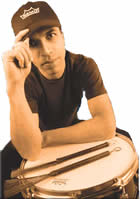 Nowadays it is a common thing to do in the music industry: send your music to a drummer and let him or her record the drum tracks at home in his own studio. Much cheaper with less of stress of organization. Drummers like Kenny Aronoff and Dave Weckl do it for a couple of years now for many great artists. Sallaberry from Brazil produced his album the other way around: he provided the drum tracks for 22 musicians and let them build the song around them. A unique concept with a unique result.
Nowadays it is a common thing to do in the music industry: send your music to a drummer and let him or her record the drum tracks at home in his own studio. Much cheaper with less of stress of organization. Drummers like Kenny Aronoff and Dave Weckl do it for a couple of years now for many great artists. Sallaberry from Brazil produced his album the other way around: he provided the drum tracks for 22 musicians and let them build the song around them. A unique concept with a unique result.© Drummerszone.com 2002-2025 Drummerszone.com is a Musicpublishers.nl website.
Oops, you're not logged in!
The more you like
the more you get!
